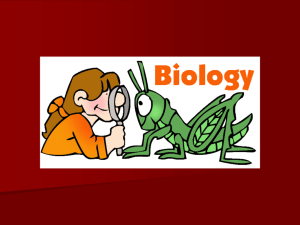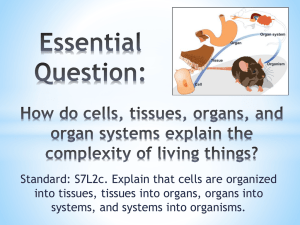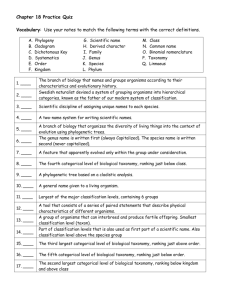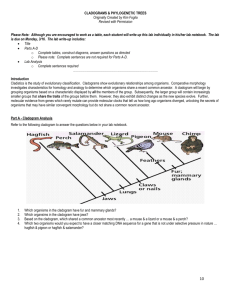Classification of Living Things:
advertisement
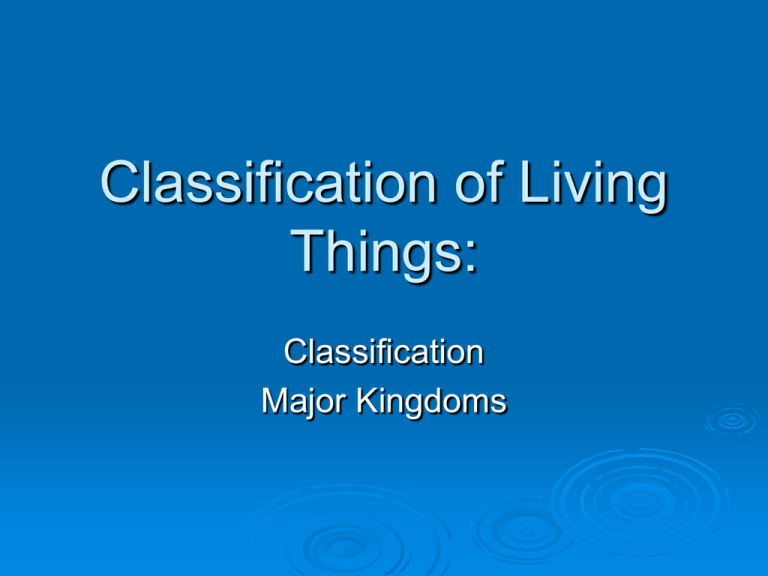
Classification of Living Things: Classification Major Kingdoms History of Classification Aristotle 384 BC Species were identified as Plants or Animals History of Classification Carolus Linnaeus 1707-1778 Developed our modern classification system Binomial nomenclature (two names) • Ex. Homo sapiens CAPITALIZED lowercase Italicize!!! Linnaean Classification Organizes organisms into groups and subgroups based on evolutionary relationships Often revised when new relationships are discovered (DNA evidence) Example: Pseudocalanus spp. Classification levels: Kingdom (broad) Phylum Class Order Family Genus Species (specific) 6 Kingdoms of Life Purves et al., Life: The Science of Biology, 4th Edition, by Sinauer Associates and WH Freeman http://cas.bellar mine.edu/tietje n/ZooLabs/Intr oduction%20to %20Taxonomy. htm Prokaryotic Kingdoms The Monera Kingdom split into Kingdom Eubacteria Kingdom Archaebacteria Only kingdoms of prokaryotic organisms Have a cell wall Lack membrane-bound organelles Lack multicellular forms. Kingdom Archaebacteria Unicellular Prokayotic Extreme environments (near volcanic activity) don’t need oxygen, light Three divisions of archaebacteria: Methanogens: methane producing organisms Thermophiles: These can live in extremely hot, acidic environments like sulfur springs. Halophiles: Can only live in bodies of concentrated salt water, like the Dead Sea. KINGDOM EUBACTERIA Unicellular Prokaryotic Extreme environments HETEROTROPHS: This bacteria lives about anywhere, including in your body in the form of a parasite. AUTOTROPHS: Obtain energy through photosynthesis. blue-green bacteria chlorophyll • They live in chains in ponds, lakes, and moist regions. CHEMOTROPHS: Produce energy by converting inorganic matter into organic matter. http://danmarkltd.tripod.com/taxonomy/id6.html Kingdom Protista The most ancient eukaryotic kingdom A variety of eukaryotic body forms: Can be single-celled, colonial, or multicellular Can be heterotrophic or autotrophic Basically eukaryotes that are NOT fungi, animals, or plants. Kingdom Fungi Eukaryotic Heterotrophic Usually multicellular group multinucleated cells enclosed in cells with cell walls Obtain energy by decomposition and absorption Some fungi Cause disease (yeast infections, rusts, and smuts), Others are useful in baking, brewing, and sources for antibiotics. http://mycorrhizas. info/ecmf.html Kingdom Plantae Immobile Multicellular eukaryotes Produce their food by photosynthesis (autotrophs) Cell wall (cellulose) Important sources of oxygen, food, and clothing/construction materials, as well as pigments, spices, dyes, and drugs. Kingdom Animalia Multicellular Heterotrophic eukaryotes Mobile at some stage during their lives Lack cell walls Animals provide food, clothing, fats, scents, companionship, and labor. Cladistics Organisms are defined and grouped based on shared features (called characters) derived from a common ancestor. Cladistics Uses branching diagrams called cladograms http://evolution.berkeley.edu/evolibrary/article/0_0_0/phylogenetics_02 Parts of a Cladogram Branches Organism Node Name of Group Feature(s) or Character(s) Reading a Cladogram Each “V” shows organisms that share a common ancestor Organism B Organism A Common Ancestor of Organisms A and B Reading a Cladogram The smaller the V, the more closely related the organisms are… Organism B Organism A Common Ancestor of Organisms A and B …and the more characters they share… Reading a Cladogram Organism B Organism A Common Ancestor of Organisms A and B All the characters below the V! Reading a Cladogram Organism C Organism B Organism A Common Ancestor of Organisms A, B and C Reading a Cladogram Organism B Organism C Organism D Common Ancestor of Organisms A, B, C and D Organism A Reading a Cladogram Organism B Organism C Organism D Organism E Common Ancestor of Organisms A, B, C, D and E Organism A Step 1: Make a table NES Directional Pad Curved Edge Control Stick Wireless Motion Sensitive SNES N64 GameCube Wii Remote Step 2: Complete a Venn Diagram Step 3: Draw a Cladogram





